April 2008
Monthly Archive
Monthly Archive
Posted by justin on 29 Apr 2008 | Tagged as: acquisitions, r.i.p.

(Photo : Stefan Pangritz)
This morning I woke up around 8:30 am, slightly restless and uneasy. I sat on my bed for about an hour and read a chapter out of Andrew Weil’s “From Chocolate to Morphine,” which just happened to have fallen out of my bookshelf over the King William Fair. It happened to be that the page I turned to was the one detailing how Albert Hofmann had first discovered LSD-25 in 1938. I read the whole story on Albert and continued throughout my day. At several points today small snippets of what I read came back to “bite,” me so to speak within my normal everyday conversations. This was driven even further home by a headline I saw that popped up onto my home page just now signing in to check my email. “LSD Creator Albert Hofmann dies at 102,” it said. The biggest shiver ran down my spine. I don’t normally catch up on drug history in the morning, and I certainly don’t expect my catching up to echo current events. heres a link to an obituary in the UK Telegraph about the man and his accomplishments and beliefs. (more info – NYTimes)
Posted by ben on 27 Apr 2008 | Tagged as: ceramics, essays

Fountain Vase by George Ohr (ca. 1895-1900)
This afternoon I was skimming over George Brecht’s 1966 essay Chance Imagery; and as I was reading this essay which traces the use of chance techniques in painting back to Kandinsky in 1911, I was drinking water from a handmade porcelain cup given to me by local potter Brad Lum, with its drips of glaze flowing haphazardly down the side. It occurred to me that just around the time that painting began to embrace chance operations, they were being eliminated from ceramics as a result of industrialization. How odd, I thought, that the western artist saw fit to insert chance into a deterministic art form like painting, rather than embrace an essentially chance-based art form like ceramics. Perhaps it is no coincidence that George Ohr is considered by some to be a precursor to the Dada movement in America.
Posted by ben on 24 Apr 2008 | Tagged as: design, music
Since I presumed to compare Brian Eno’s Music for Airports to Satie’s formulation of ‘furniture music’ in this post, I thought I’d let Mr. Eno have his say:
Whereas the extant canned music companies proceed from the basis of regularizing environments by blanketing their acoustic and atmospheric idiosyncrasies, Ambient Music is intended to enhance these. Whereas conventional background music is produced by stripping away all sense of doubt and uncertainty (and thus all genuine interest) from the music, Ambient Music retains these qualities. And whereas their intention is to ‘brighten’ the environment by adding stimulus to it (thus supposedly alleviating the tedium of routine tasks and leveling out the natural ups and downs of the body rhythms) Ambient Music is intended to induce calm and a space to think.
— Brian Eno, in the liner notes to Music for Airports
Posted by ben on 24 Apr 2008 | Tagged as: design, silliness
Daniel Finkelstein discusses the intricacies of logo design.
Posted by ben on 23 Apr 2008 | Tagged as: performance art, responses/reviews, video/film
I have a piece in last week’s Current discussing the work of Regina José Galindo (currently at Artpace). It’s not so much a review as a discussion of the history of Galindo’s work, and the way that it brings protest strategies into a visual art context. There’s a lot I couldn’t get to in that article, though, and thought I might dig into that a little bit here.
One thing that struck me about the work at Artpace is the contrasting uses of performance and documentation by Kate Gilmore, Regina José Galindo, and Margarita Cabrera. (Although Rodney McMillian incorporated performance and documentation into his work, for various reasons I won’t be discussing him in this post.) Galindo’s performance draws from a protest tradition — at Artpace, she locked herself along with her husband and daughter in a mobile prison cell in the gallery. Also, like a protester, she views her performances as her artwork, while the videos and photographs that are generated from them are purely documentation of the performance — not individual works of art, but necessary to spread “word of the performance and the message.” However, when she discusses her intentions and expectations, Galindo never mentions social change:
I suppose that—like everything I do—this was done for me…. I never have any expectations after completing something. What I do have is a certain amount of nervousness and anxiety before every performance. But after that I have no expectations. It’s done.
So in this way at least, it is distinct from protest which aims to catalyze social change.
Like Galindo, Kate Gilmore puts herself into dangerous or difficult situations in order to comment from a personal perspective on the systemic problems that prevent human progress. But the similarities end there. Gilmore’s work consists of performances on video (the videos being, in this case, the artworks, while the performances become simply part of the process of creating the work). The situations Gilmore puts herself in don’t target material injustices, but are created by the artist. She sets her foot in a bucket of cement, lets the cement dry, and then sets about the task of breaking her foot out of the cement with a hammer. This kind self-imposed task suggests an allegorical confrontation with psychological barriers more than a way to address specific injustices (although these barriers are connected to societal inequities).
Margarita Cabrera takes a different tack. She turns the gallery space into a makeshift copper butterfly factory, and recruits community volunteers to make 2,500 butterflies by hand. This strategy recalls the work of Harrell Fletcher, who often addresses divisions within communities by organizing collaborative events. However, Cabrera does, like Galindo, deal with concrete issues of ongoing social injustice. The workshop Cabrera builds is meant to signify the maquiladoras (low-wage manual labor factories, often with lax labor law enforcement) in Mexico. By “exporting” the butterflies to the home of a wealthy San Antonio collector, Cabrera targets economic systems that hide the human costs of a product from its owners by separating the craft from the craftsman. The documentation plays a minor role in this work: a photograph of the butterfly installation is affixed to the wall of the workshop. In another parallel to Galindo’s work, Cabrera leaves the workshop for gallery visitors to explore, so that a trip to the gallery gets you an experience of the residue of her artwork.
The interplay between these exhibits helps flesh out the contours of performance in contemporary art. Each artist works with performance strategies that articulate a distinct relationship between artist and community. By placing these shows side-by-side, Artpace encourages the visitor to contemplate approaches to social critique: The direct, literal commentary of Galindo, or the allegory of Gilmore. The interpersonal relations of Cabrera or the personal goals of Galindo. The roles of document and sediment in the artistic process.
Posted by ben on 21 Apr 2008 | Tagged as: adventure day, essays, poetry
Yesterday the Washington Post published a little reflection by Edward Hirsch on the connection between walking and poetry [hat tip]. He threads his own poetic footsteps with those of Baudelaire, Frost, Blake, and a host of others. The piece has an interesting resonance with a lecture Hirsch gave last year at Trinity University, in which he compares the act of reading to pulling a message from a bottle drifting in the sea. We can see him wandering along the beach, gathering the bottles tossed into the waves by poets on distant shores; and to stretch the metaphor further, uncorking a missive sent through the oceanic postal system of memory by the nascent poet in an 8-year-old Edward Hirsch.
Mostly, though, this discussion of long, poetic walks reminds me of Julio Cortazar’s Hopscotch. The opening passage introduces lovers who wander the streets of Paris, dating by chance:
Would I find La Maga? Most of the time it was just a case of my putting in an appearance, going along the Rue de Seine to the arch leading into the Quai de Conti, and I would see her slender form against the olive-ashen light which floats along the river as she crossed back and forth on the Pont des Arts, or leaned over the iron rail looking at the water. It was quite natural for me to climb the steps to the bridge, go into its narrowness and over to where La Maga stood. She would smile and show no surprise, convinced as she was, the same as I, that casual meetings are apt to be just the opposite, and that people who make dates are the same kind who need lines on their writing paper, or who always squeeze up from the bottom on a tube of toothpaste.
Posted by justin on 16 Apr 2008 | Tagged as: adventure day, bird flu, in yo face, mustaches, party photos, possibilities, renegade performances
Posted by ben on 16 Apr 2008 | Tagged as: acquisitions, design, poetry
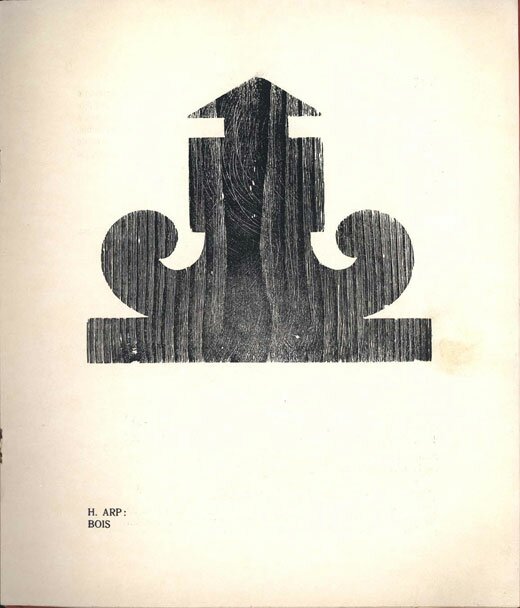
UbuWeb recently posted issues 1-3 of Tristan Tzara’s Dada magazine, which ran from 1917 to 1919. Unfortunately, they didn’t post the final, combined issue 4-5, which features some important works by Picabia, as well as Arp, Breton, Cocteau, and Radiguet. Still, a great little contribution to UbuWeb’s amazing archive.
Posted by ben on 15 Apr 2008 | Tagged as: design, music
“Nevertheless, we must bring about a music which is like furniture — a music, that is, which will be part of the noises of the environment, will take them into consideration. I think of it as melodious, softening the noises of the knives and forks, not dominating them, not imposing itself. It would fill up those heavy silences that sometimes fall between friends dining together. It would spare them the trouble of paying attention to their own banal remarks. And at the same time it would neutralize the street noises which so indiscreetly enter into the play of conversation. To make such music would be to respond to a need.” — Erik Satie, prophesying Muzak.
Isn’t it interesting that architects have not taken up music as a part of their discipline? We have all this music now which is piped in but bears no particular relationship to the space which it inhabits. I suppose the only architectural sound works I’ve experienced are the pieces Max Neuhaus created for Dia:Beacon and Times Square. He’s on the verge of installing another permanent sound installation at the Menil in Houston on May 3, which will be only the third permanent sound work of his in the United States.
Neuhaus doesn’t conceive these works in the way that Erik Satie talked about ‘furniture music’ — he speaks instead of using the sound to “transform the space into a place” — and I think this notion is more socially sensitive than Satie’s conception. Satie’s idea is probably closer to Brian Eno’s Music for Airports, which, although it was created for a specific airport, was never “installed” in that space, and now exists as just another ambient recording.
Update: Just to clarify, what I’m talking about here is not the quality of Satie’s compositions, but his conception of ‘furniture music.’ Knowing that Max Neuhaus was a follower of John Cage’s, and that Cage studied Satie’s work very closely, I take Neuhaus’ work as a refinement of the idea of ‘furniture music.’ I’m not sure that he would see it this way, but this seems to be very a plausible thread. Since Neuhaus has had the opportunity to fully put this concept into practice in diverse environments, the idea naturally evolved from Satie’s original notion. What Neuhaus is doing seems to be less of a social intervention than what Satie talks about in the quote above — it changes your awareness of space, but doesn’t spare you the trouble of paying attention to banal remarks. The notion that Music for Airports is closer than Neuhaus’ installations to Satie’s concept of ‘furniture music’ may not be as defensible.
Posted by ben on 15 Apr 2008 | Tagged as: arts organizations, politics
When various folks in the art world became concerned recently that Smithson’s Spiral Jetty was going to be threatened by new oil exploration, I wondered what the big deal was. As I understand it, when Smithson created the piece, the site was very close to an industrial jetty actively used for oil exploration. In a new piece for The American Prospect, Kriston Capps addresses this point and much more. What’s most interesting about this situation, though, is that there appear to be genuine ecological concerns with oil exploration in the lake — and yet it is the Spiral Jetty that has rallied people from around the world to object to the drilling. According to Capps:
Though some of the complaints were more generic in nature — oil wells are never welcomed with open arms, even in remote areas like Rozel Point — Jemming characterized the overwhelming majority of correspondence his office received as primarily “comments related to the Spiral Jetty from the arts community.”
Give the piece a read for an interesting look at the intersection of art, ecology, and politics. TAP also has a Q&A with Nancy Holt, Smithson’s widow, and Lynn de Freitas, director of Friends of Great Salt Lake.
Posted by ben on 14 Apr 2008 | Tagged as: acquisitions, borders, vs.
“Art and money never touch. They exist in parallel universes of value at comparable levels of cultural generalization: Art does nothing to money but translate it. Money does nothing to art but facilitate its dissemination and buy the occasional bowl of Wheaties for an artist or art dealer. Thus, when you trade a piece of green paper with a picture on it, signed by a bureaucrat, for a piece of white paper with a picture on it, signed by an artist, you haven’t bought anything, since neither piece of paper is worth anything. You have translated your investment and your faith from one universe of value to another.” — Dave Hickey, Dealing
“According to this system, bodies act as if there were no souls (though this is impossible); and souls act as if there were no bodies; and both act as if each influenced the other.” — G.W. Leibniz, The Principles of Philosophy, or, the Monadology
Posted by justin on 14 Apr 2008 | Tagged as: adventure day, art paparazzi
..a few things I experienced this weekend in San Antonio.
Seeing the EPA, back on site at the old Big Tex Grain Silos, testing again? (last update from SA Current) Riding my bike by today it seemed like they were set up for the night, this would make the second time they have spent time gathering samples here. When I spoke with the manager onsite last time he told me it was a waiting game, if the results came back conclusive they would be back for more tests..It was turned into an EPA Superfund site sometime last year(oops, maybe longer).
(disclosure : I shot this photo weeks ago for the Current, when the EPA were first onsite.. I had to be driven onto the property in a protected vehicle..It was not the first time I had to question the four years I spent out here working on and inside of FL!GHT Gallery, which was once housed in the now fenced off Silo # 18)
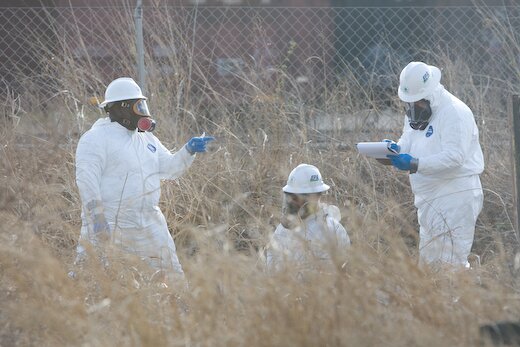
One more of the mayors new projects came online last night, the reopening/renovation of Main Plaza (in front of San Fernando Cathedral) was celebrated with a fountain lighting and an LED piece with the San Antonio Symphony and Bill FitzGibbons collaborating..

Also opening with much fanfare was Mignon Harkraders “Swellegant,” this last Second Saturday at FL!GHT. We’re all pretty proud of the improvements in our dry goods room around here also (2nd image). Mignon’s show will be up through the end of the month.
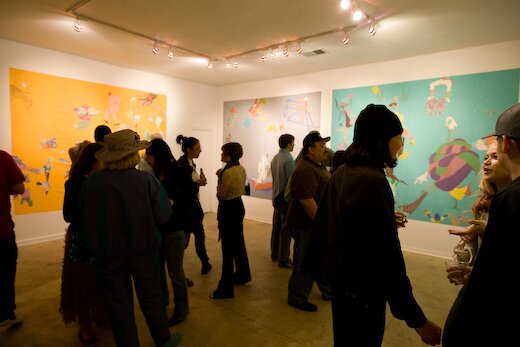
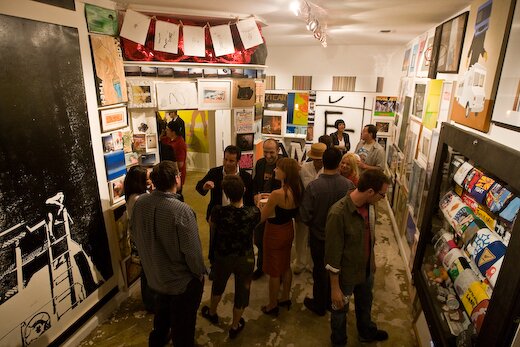
Posted by ben on 14 Apr 2008 | Tagged as: arts organizations, borders, politics, responses/reviews
There have been a few little dust-ups in the art world lately regarding conflicts of interest among art critics. Edward Winkleman has the skinny on a feud between art critics Tyler Green (of Modern Art Notes) and Christian Viveros-Fauné (formerly of the Village Voice). Green likes to split his blogging time between criticism and more journalistic pursuits, such as scooping the big papers on the departures of major museum directors. He also likes to call out arts writers for lacking journalistic integrity. After Green pointed out that Viveros-Fauné is a director of the Volta art fair, and an organizer of Chicago’s Next art fair, Viveros-Fauné was canned from his Village Voice position over what was seen as a conflict of interest. Of course, Viveros-Fauné then accused Green of being a self-promotional wanker (spelling Green’s name with an extra ‘e’, presumably to thank him for leaving the accent off Viveros-Fauné in an interview published on Modern Art Notes).
Now this battle has broadened a bit (the comments on Winkleman’s post give a good idea of the range of opinions), and people seem to be dividing into two camps: art critics should follow journalistic standards; or art critics should do whatever the hell they want, they will be judged according to the quality of their writing, period.
When it gets down to it, the art community is entering a phase of commercialization that makes this a very difficult issue to address. As more money flows into the contemporary art world, and as people start to see art as more of a financial investment, the problems that Tyler Green addresses become much more important. Investors want transparency and high ethical standards. However, this commercialization has met with resistance in some quarters, among people who feel that art should be free of the taint of commerce as well as the kind of compartmentalization that these ethical standards often bring.
Artists want to be free to write about art, open their own art spaces, curate shows with artists they respect (often their friends) and ultimately participate in the art community on multiple levels. Everyone who writes for this blog, for instance, also produces art, and two of us have directed gallery spaces while writing about art. The idea of keeping these functions totally separate is, for many of us, antithetical to the freedom and openness that art allows.
So where do I stand on this? Well I’ll just say that I think it’s a good debate to be having. But before addressing the ethical issue per se, we need to clarify our positions on the relationship between art and money. To the extent that art is a commercial endeavor, Tyler Green is right: we need clearly defined roles that prevent conflicts of interest. To the extent that art is about investigating new ways of seeing the world, these roles have the potential to trap us in an overly calcified artistic space.
Update: Tyler Green comments to clarify that he does not see this as a feud between himself and Mr. Viveros-Fauné.
Posted by justin on 09 Apr 2008 | Tagged as: art + bikes, art paparazzi, celebrity sightings, performance art, renegade performances, rock!, silliness
Ken Littles Rodeo HO HO made its final REGULAR appearance last night. See for yourself :
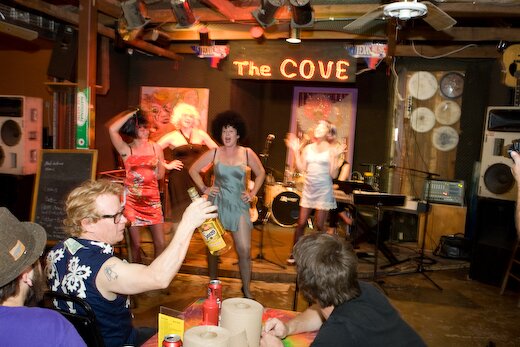
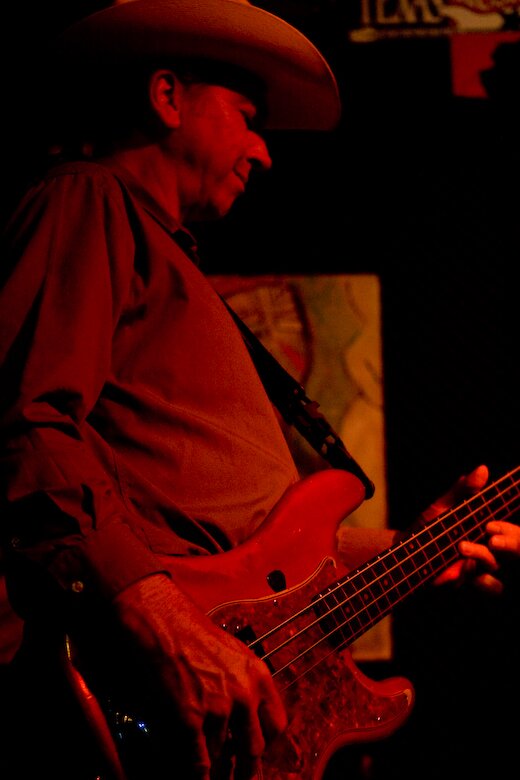

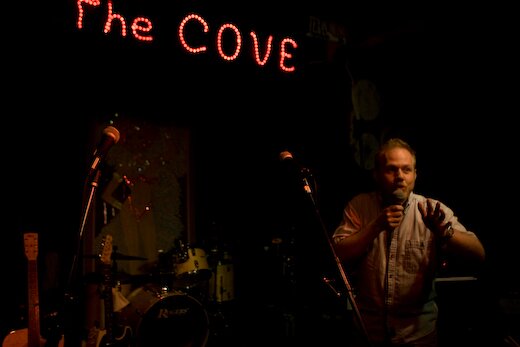

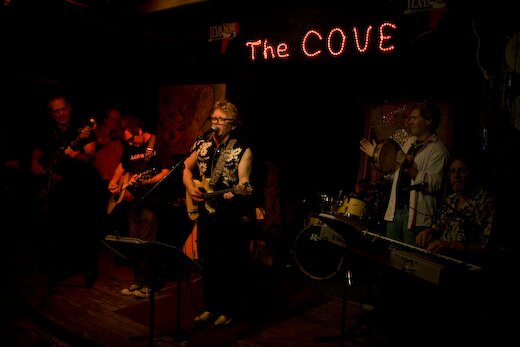
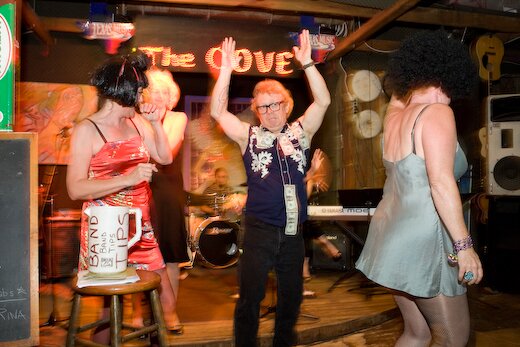
Posted by ben on 07 Apr 2008 | Tagged as: music, rock!, sound art

Mutant Sounds, one of the best underground music blogs out there, just posted a couple of albums by my all-time favorite San Antonio band, Crevice. These albums are long out of print, so if you are interested in learning just how weird San Antonio can get, grab these gems while you can. From the Mutant Sounds write-up:
Here’s a great offer by another friend of the blog, Uncle Buzz, aka Crevice. Wonderful space/cosmic, freaked out electronic compositions, amongst the best of its kind. The 1st one is a 71 minutes psych/cosmic electronic explorations lost in the depths of outer space. The second one consists of 4 log meditative sonic cosmic compositions, with eastern feeling sometimes, not far from the very early Tangerine Dream/ Kluster attempts.